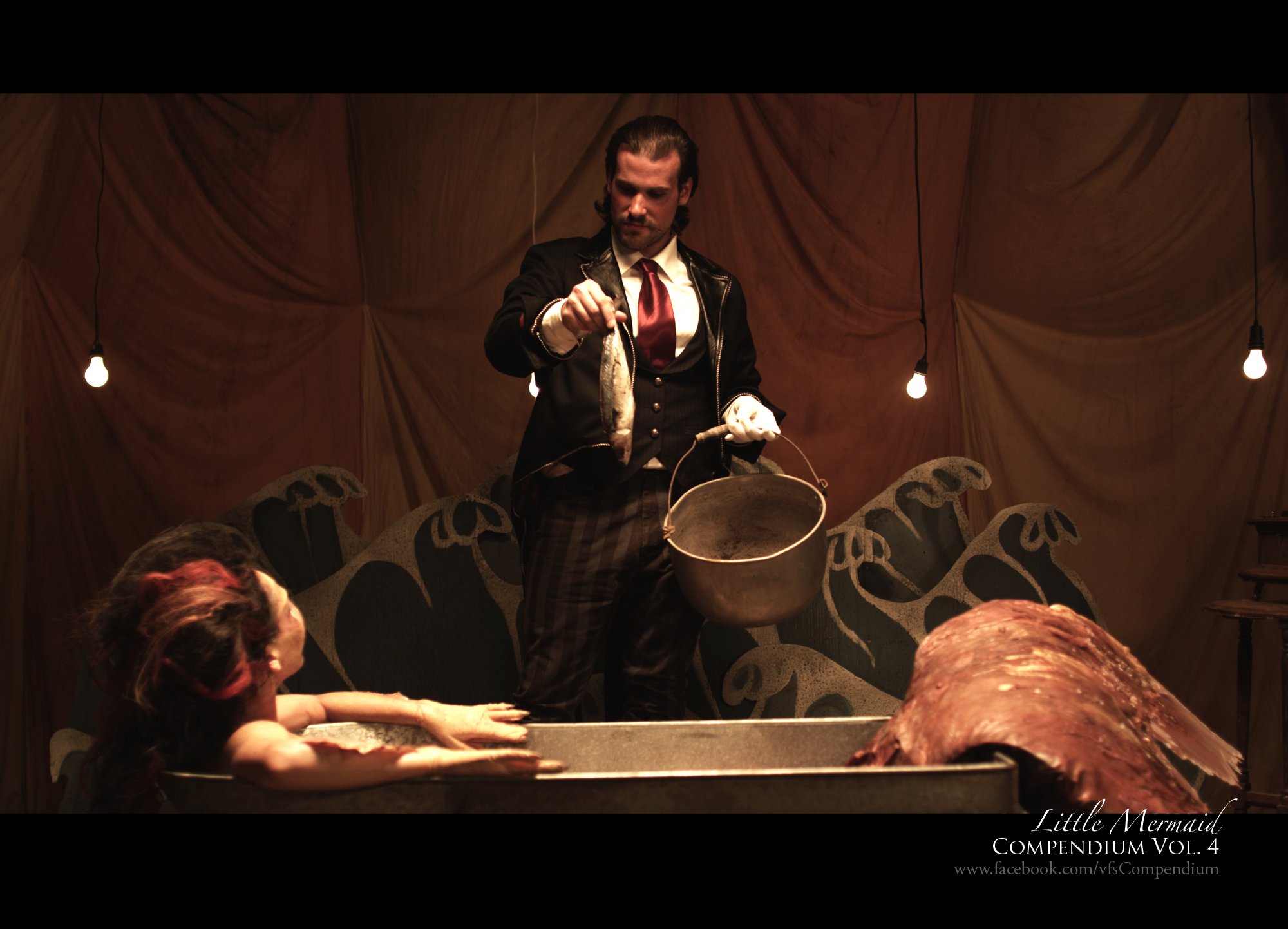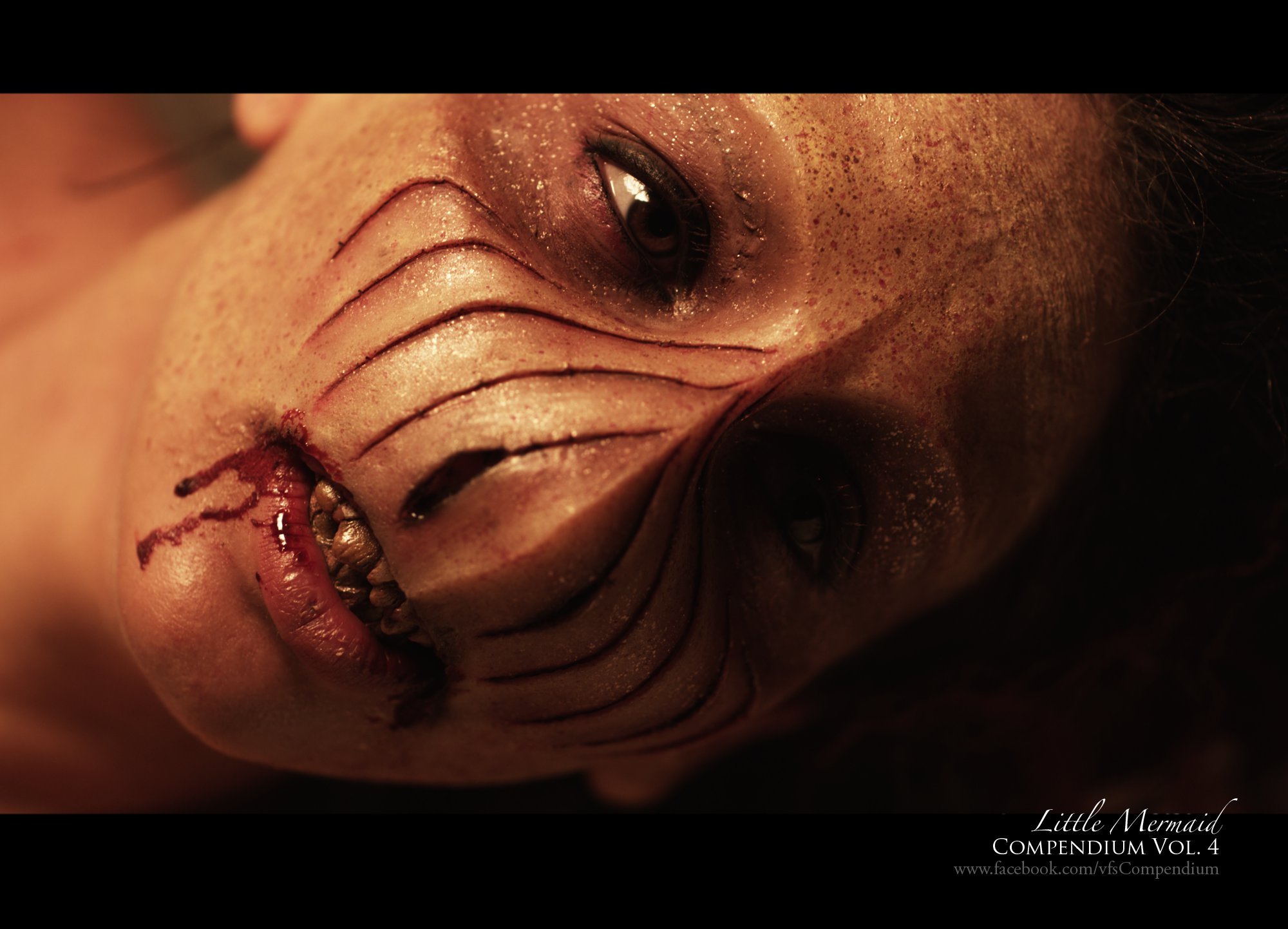Nicholas Humphries and Meagan Hotz’s “Little Mermaid” takes Hans Christian Andersen’s already dark fairy tale and reimagines the “romance” as a swamp circus freak show about worn out and faded love. Since Andersen published the tale in 1836 there have been versions in almost every possible artistic form, his first incarnation written for ballet even. Something about this little inter-species romance compels storytellers to return to it again and again.
In their retelling, Humphries and Hotz take a turn to horror. Some of the film’s shock value is intertextual: the title probably has most people referencing the Disney animated film from 1989 more than the original Andersen tale.
Humphies and Hotz can play off of the Disneyfied, technicolour-happy-ending expectations of the audience and so then shock and cause them to shudder more when the tale takes surprisingly dark turns.
In the opening shots of the film, lights swing from trees, half fruit, half pendulums keeping time’s waltz in among the mists. There is a peculiar sepia tint to the colour scheme, a surprising nostalgic and warm hue to the stagnancy and decay of the swamp setting. Throughout this opening, too, there is the flutter of birds flying off, in a way underscoring how caught and imprisoned the mermaid is when we meet her inside the worn tent. The lighting, the boardwalks across the swamp, the signage, and the tent itself seem strangely permanent for something as itinerant as a circus and this metaphorically sets the stage for the inertia, the claustrophobia of the lost love between the circus master and his imprisoned mermaid.
Though Humphries and Hotz’s dark take on the fairy tale might seem a departure, these choices are in many ways a return to the darkness of Andersen’s original tale in which the sea witch’s pact with the little mermaid carries with it terrible costs. As the sea witch explains,
“I will prepare a draught for you, with which you must swim to land tomorrow before sunrise, and sit down on the shore and drink it. Your tail will then disappear, and shrink up into what mankind calls legs, and you will feel great pain, as if a sword were passing through you. But all who see you will say that you are the prettiest little human being they ever saw. You will still have the same floating gracefulness of movement, and no dancer will ever tread so lightly; but at every step you take it will feel as if you were treading upon sharp knives, and that the blood must flow. If you will bear all this, I will help you.”
“Yes, I will,” said the little princess in a trembling voice, as she thought of the prince and the immortal soul.
Though I suppose we can forgive Disney for leaving out these terrible wounds and the awful price the mermaid is willing to pay, Andersen’s original, like Humphries and Hotz’s version, sees the pain and suffering as the point of the story.
For Andersen, this pain and suffering, the sacrifice was on a certain level a declaration of love and a tribute to the beloved. Brooke Allen in The New York Times argues that “In ‘’The Little Mermaid,’’ Hans Christian Andersen suggests that immortality can serve as a substitute, however unsatisfactory, for human love. The story is clearly an allegory for his own life, for the unloved Andersen.” What Allen is pointing to is what is present in the original tale and is missing in this most recent version: the love triangle aspect of the original fairy tale. In the Hans Christian Andersen version, despite all the little mermaid’s sacrifices, the prince marries a princess from a neighboring kingdom, an action which will doom the little mermaid to wake at dawn the next day and turn into sea foam.
This love triangle resembles another: the tale is considered by many to be a love letter, originally written from Andersen to Edvard Collin who would not return his affections and in the end married a woman. The themes around sacrifice then in that context become about unrequited love and the tale about trying to make sense and meaning out of the sometimes self-destructive sacrifices we make for it.
In the Disney version of the tale, too, there is sacrifice. But Ariel’s lack of pain and regret and its happily-ever-after ending morph the theme into one where sacrifice gets the man. Ariel still gives up her life under the sea but she gets the man in the end, so it was, Disney would have us believe, worth it.
Humphries and Hotz pick up the theme of sacrifice but in their tale it seems to be about how the lovers’ sacrifices have killed their love. Their mermaid never sacrificed her tail or her voice but she has been taken from the sea to live in a metal tub and be displayed by her lover and objectified by the curious who are willing to pay.
We can only imagine the series of bad choices (maybe his, maybe hers) that led them to this tent in the swamp. We know they are both weary. We know it’s not an equal relationship. We glimpse only shards of love’s remnants. The mermaid here begs for mercy, but the circus master can’t or won’t give it to her because he would lose this tragic-as-it-is circus. This little mermaid has to take her fairy tale’s ending into her own hands. In a nice rewrite, it is her voice’s siren call that brings him to her and makes him see her as human just before she, with a vengeful kiss, takes his tongue and voice.
This is the definition of a Pyrrhic victory: a mermaid in a tub in the swamp isn’t going to get far. Her choice is similar to Andersen’s mermaid’s, though, whose sisters appear to her and tell her that if she sheds the prince’s blood on her legs she will get her mermaid’s tail back. Kill the prince to get her old life back or uphold his happy marriage to the princess ensuring she, the mermaid, will turn to sea foam in the morning as prophesied. Though it is technically not the same choice in the Humphries and Hotz version, the mermaid does opt against her own further sacrifice and chooses to shed the circus master’s blood. She puts an end to the pathetic death of their romance and ultimately privileges mercy over sacrifice.
Humphries and Hotz’s “Little Mermaid” was produced as part of the Vancouver Film School’s Compendium series out of their Entertainment Business Management Program. It’s garnered numerous nominations and several prestigious awards including Best Short at Screamfest LA. Humphries dark sensibility gave Numero Cinq at the Movies its Valentine’s Day installment last year with “The One That Got Away.”
–R.W.Gray




